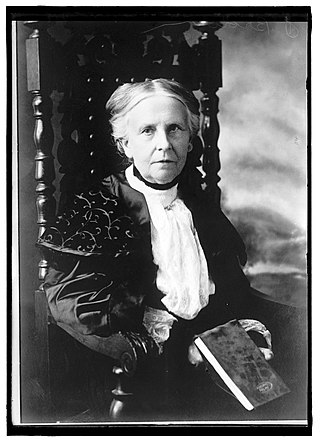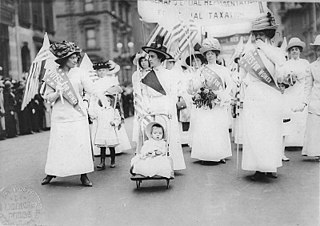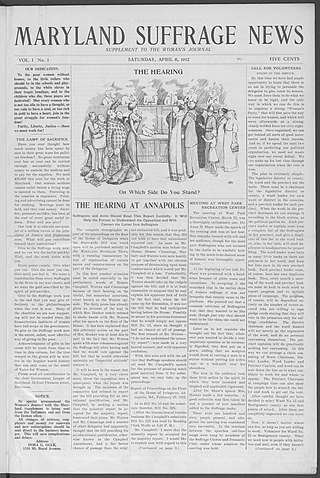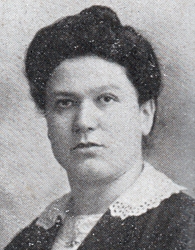Related Research Articles

Crystal Catherine Eastman was an American lawyer, antimilitarist, feminist, socialist, and journalist. She is best remembered as a leader in the fight for women's suffrage, as a co-founder and co-editor with her brother Max Eastman of the radical arts and politics magazine The Liberator, co-founder of the Women's International League for Peace and Freedom, and co-founder in 1920 of the American Civil Liberties Union. In 2000, she was inducted into the National Women's Hall of Fame in Seneca Falls, New York.

Olympia Brown was an American minister and suffragist. She was the first woman to be ordained as clergy with the consent of her denomination. Brown was also an articulate advocate for women's rights and one of the few first generation suffragists who were able to vote with the passage of the Nineteenth Amendment.
Liberal feminism, also called mainstream feminism, is a main branch of feminism defined by its focus on achieving gender equality through political and legal reform within the framework of liberal democracy and informed by a human rights perspective. It is often considered culturally progressive and economically center-right to center-left. As the oldest of the "Big Three" schools of feminist thought, liberal feminism has its roots in 19th century first-wave feminism seeking recognition of women as equal citizens, focusing particularly on women's suffrage and access to education, the effort associated with 19th century liberalism and progressivism. Liberal feminism "works within the structure of mainstream society to integrate women into that structure." Liberal feminism places great emphasis on the public world, especially laws, political institutions, education and working life, and considers the denial of equal legal and political rights as the main obstacle to equality. As such liberal feminists have worked to bring women into the political mainstream. Liberal feminism is inclusive and socially progressive, while broadly supporting existing institutions of power in liberal democratic societies, and is associated with centrism and reformism. Liberal feminism tends to be adopted by white middle-class women who do not disagree with the current social structure; Zhang and Rios found that liberal feminism with its focus on equality is viewed as the dominant and "default" form of feminism. Liberal feminism actively supports men's involvement in feminism and both women and men have always been active participants in the movement; progressive men had an important role alongside women in the struggle for equal political rights since the movement was launched in the 19th century.
The history of feminism comprises the narratives of the movements and ideologies which have aimed at equal rights for women. While feminists around the world have differed in causes, goals, and intentions depending on time, culture, and country, most Western feminist historians assert that all movements that work to obtain women's rights should be considered feminist movements, even when they did not apply the term to themselves. Some other historians limit the term "feminist" to the modern feminist movement and its progeny, and use the label "protofeminist" to describe earlier movements.

Hubertine Auclert was a leading French feminist and a campaigner for women's suffrage.

The National Woman's Party (NWP) was an American women's political organization formed in 1916 to fight for women's suffrage. After achieving this goal with the 1920 adoption of the Nineteenth Amendment to the United States Constitution, the NWP advocated for other issues including the Equal Rights Amendment. The most prominent leader of the National Woman's Party was Alice Paul, and its most notable event was the 1917–1919 Silent Sentinels vigil outside the gates of the White House.
The Revolution was a newspaper established by women's rights activists Susan B. Anthony and Elizabeth Cady Stanton in New York City. It was published weekly between January 8, 1868, and February 17, 1872. With a combative style that matched its name, it primarily focused on women's rights, especially prohibiting discrimination against women's suffrage in the United States, and women's suffrage in general. It also covered other topics, such as politics, the labor movement, and finance. Anthony managed the business aspects of the paper, while Stanton was co-editor along with Parker Pillsbury, an abolitionist and a supporter of women's rights.

Anti-suffragism was a political movement composed of both men and women that began in the late 19th century in order to campaign against women's suffrage in countries such as Australia, Canada, Ireland, the United Kingdom and the United States. To some extent, Anti-suffragism was a Classical Conservative movement that sought to keep the status quo for women. More American women organized against their own right to vote than in favor of it, until 1916. Anti-suffragism was associated with "domestic feminism," the belief that women had the right to complete freedom within the home. In the United States, these activists were often referred to as "remonstrants" or "antis."

Doris Stevens was an American suffragist, woman's legal rights advocate and author. She was the first female member of the American Institute of International Law and first chair of the Inter-American Commission of Women.

Feminism is aimed at defining, establishing, and defending a state of equal political, economic, cultural, and social rights for women. It has had a massive influence on American politics. Feminism in the United States is often divided chronologically into first-wave, second-wave, third-wave, and fourth-wave feminism.

The Woman's Bible is a two-part non-fiction book, written by Elizabeth Cady Stanton and a committee of 26 women, published in 1895 and 1898 to challenge the traditional position of religious orthodoxy that woman should be subservient to man. By producing the book, Stanton wished to promote a radical liberating theology, one that stressed self-development. The book attracted a great deal of controversy and antagonism at its introduction.

Clara Campoamor Rodríguez was a Spanish politician, lawyer and writer, considered by some the mother of the Spanish feminist movement. She was one of the main promoters for women's suffrage in Spain, included in the Spanish Constitution of 1931 in part owing to her advocacy.

Clara Dorothy Bewick Colby was a British-American lecturer, newspaper publisher and correspondent, women's rights activist, and suffragist leader. Born in England, she immigrated to the US, where she attended university and married the former American Civil War general, later Assistant United States Attorney General, Leonard Wright Colby. In 1883, she founded The Woman's Tribune in Beatrice, Nebraska, moving it three years later to Washington, D.C.; it became the country's leading women's suffrage publication. She was an advocate of peace and took part in the great peace conference at San Francisco during the exposition. She also spoke on behalf of the soldiers of the Spanish War. During the Spanish–American War (1898), she was officially appointed as war correspondent, the first woman to be so recognized.

The socio-political movements and ideologies of feminism have found expression in various media. These media include newspaper, literature, radio, television, social media, film, and video games. They have been essential to the success of many feminist movements.
Women's Progressive Society was a suffrage pressure group formed in London in 1890 that rapidly gained an international membership. It led to the formation of the International Women's Union in 1893.

The Maryland Suffrage News was a weekly newspaper founded in Baltimore, Maryland in 1912 by Edith Houghton Hooker as the voice of the Just Government League (JGL) of Maryland, a pro-women's suffrage organization that she founded in 1909. Hooker was the editor of the paper and Dora G. Ogle was the business manager, while Hooker and her husband, Donald R. Hooker, provided the main financial backing. Members of the National American Women's Suffrage Association (NAWSA) could subscribe to the national Woman’s Journal (Boston) and the Maryland Suffrage News at the same time, but the Maryland Suffrage News also was available by separate subscriptions. Eventually, the JGL affiliated with the National Woman's Party, a group that advocated for suffrage via congressional amendment, a stance that led to its withdrawal from the NAWSA.

Ada Sacchi Simonetta was an Italian librarian and women's rights activist. During her tenure as the head of the public library and museums in Mantua, she introduced new services and programs to make the library more democratic and reach more people, including Sunday hours, a public card catalog, and hospital libraries for soldiers during World War I. Driven by the difficult economic conditions faced by libraries in Italy, Sacchi founded a national association for library and museum officials, which advocated for library and museum interests in Italy, and eventually became part of the Italian Library Association. Sacchi was also active in the Italian women's rights movement, founding the Mantuan chapter of the Association for the Woman and serving as president of the Italian Federation for Women's Suffrage and Civil and Political Rights.
The Queen Bee, formerly known as The Colorado Antelope was an American journal dedicated to women's rights. The paper was founded by Caroline Nichols Churchill in Denver in 1879. The Antelope came out monthly until 1882, when Churchill moved to a weekly format and renamed the paper the Queen Bee. The paper was popular and was praised by Susan B. Anthony. Both papers covered various issues, including women's suffrage, race, and had a strong pro-feminist stance. Churchill continued to publish the paper until a few months before she died in 1926.
Clara W. MacNaughton was an American dentist and suffragist.
References
- ↑ Henry, E. Claire (August 1991). "Clara Bewick Colby and the Woman's tribune, 1883-1909 : the free lance editor as movement leader". In Martha Watson (ed.). A Voice Of Their Own: The Woman Suffrage Press, 1840-1910 . University of Alabama Press. ISBN 978-0817305260.
- ↑ "The Woman's Tribune ([Beatrice, Neb.]) 1883-1909 [Microfilm Reel]". Library of Congress. Retrieved 2020-03-31.
- ↑ Bloomberg, Kristin Mapel (2006). "Cultural Critique and Consciousness Raising: Clara Bewick Colby's Woman's Tribune and Late-Nineteenth-Century Radical Feminism". In James P. Danky and Wayne A. Wiegand (ed.). Women in Print. The University of Wisconsin Press. pp. 27–63. ISBN 9780299217846.
- ↑ Willis, Olympia Brown; Stone, Lucy; National American Woman Suffrage Association Collection (Library of Congress) DLC [from old catalog] (1917). Democratic ideals; a memorial sketch of Clara B. Colby. unknown library. [The Federal suffrage association]. p. 36.
- ↑ Lomicky, Carol S. (2002-10-01). "Frontier Feminism and the Woman's Tribune: The Journalism of Clara Bewick Colby". Journalism History. 28 (3): 102. ISSN 0094-7679.